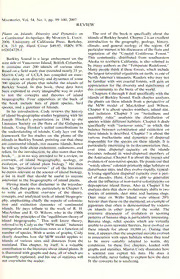
Plants on Islands: Diversity and Dynamics on a Continental Archipelago by Martin L. Cody PDF
Preview Plants on Islands: Diversity and Dynamics on a Continental Archipelago by Martin L. Cody
Madrono, Vol. 54, No. 1, pp. 99-100, 2007 REVIEW Plants on Islands: Diversity and Dynamics on The rest of the book is specifically about the a ContinentalArchipelago. By MARTIN L. CODY. islands ofBarkley Sound. Chapter2 is an excellent 2006. University of California Press, Berkeley, introduction to the geography, geology, history, CA. 315 pp. Hard Cover $49.95. ISBN 978- climate, and general ecology of the region. Of 052024729-1. particular interest is his discussion ofthe flora and vegetation of the "Coastal Coniferous Forest." Barkley Sound is a large embayment on the This community, distributed from southeastern west side ofVancouver Island, British Columbia. Alaska to northern California, is also referred to IBtasceodntoaninasfioevlderstu2d0y0thiastlaenxdtsenodfedvanreiaorulsy 2s5izyesr., bMyanmyanpyeoapultehotrhsinaksifthtehe"sTeefmopreesrtas,tewhRiacihnfoirnecsltu,d"e Martin Cody of UCLA has compiled an enor- the largest terrestrial organisms on earth, as one of mous data set on diversity and dynamics ofsome North America's treasures. Readers who may not 300 species of plants that inhabit the islands of be familiar with wet coastal forests, will gain an Barkley Sound. In this book, these data have appreciation for the diversity and significance of been exploited in every imaginable way in order this community to the biota ofthe world. to test the concepts and theories of island Chapters 4 through 8 deal specifically with the biogeography. Four appendices at the back of islands of Barkley Sound. Each chapter analyzes the book include lists of plant species, bird tthhee pMla/ntWs omnodtheelseoifslaMnadscAfrrtohmura paernsdpecWtiilvseono.f species, and a gazetteer of Islands. In his introduction, Cody reviews the history Chapter 4 is about species numbers, island size, and isolation. Chapter 5 on "nestedness and ofisland biogeographic studies beginningwith Sir assembly rules" analyzes the distribution of Joseph Hooker's presentation in 1846 to the species within different habitats. Chapter 6 deals Linnaean Society on the flora of the Galapagos specifically with "turnover rates," in which the Islands. Using Hooker's initial contributions to balance between colonization and extinction on the understanding of islands, Cody lays out the framework for his studies on the plants of the these islands is described. Chapter 7 is about the various mechanisms and dynamics of dispersal islands in Barkley Sound, pointing out that these responsible for the species on these islands. It is are continental islands, not oceanic islands, hence particularly interesting in its documentation that, he will say little about endemism, radiations, and over time, dispersal capacity on the islands relicts. In the introduction, he also states that this becomes reduced in wind-dispersed members of book, "...is in no way intended to be a review, or the Asteraceae. Chapter 8 is about the impact and overview, of island biogeography, ecology, or evolution ofnon-nativespecies. Hepoints out that evolution, or of island plant biology." He then "weedyaliens" colonizeprimarilyedgehabitats or lists his ''personal favorites" of all the literature disturbance sites, and they evolve rapidly, typical- he deems relevant to the science ofisland biology, ly losing significant dispersal capacity over a peri- a list in itself that should be useful to anyone od of decades. Here, Cody is able to generalize interested in the biogeography of island plants. about theinfluenceofnon-nativecolonizationson Having made that disclaimer in the introduc- depauperate island floras. Also in Chapter 8 he tion, Cody then goes on, particularly in Chapter 3, analyzes data that show evolutionary shifts in two to write an excellent overview of the theory, species of animals, deer mice and banana slugs. concepts, and analytical tools ofisland biogeogra- Deer mice on Willis Island were almost 20% phy, emphasizing chiefly the aspects of coloniza- heavierthan thoseon themainland, anexampleof tion and extinction dynamics of continental gigantism that often is demonstrated by rodents islands. He pays tribute to the work of R. H. on islands in other parts of the world. The MacArthur and E. O. Wilson, who in the 1960s extensive discussion of evolution in spotting laidouttheprinciplesofthe "equilibriumtheoryof patternsofbananaslugsisparticularlyinteresting. island biogeography." This well know theory, Banana slugs, relict species which are virtually referredto byCodyasthe"MAVmodel," balances unable to cross seawater barriers, have evolved on immigration and extinctions rates as a function of these islands for about 10,000 yr. During that cnluemarbleyrdeosfcrspiebceisesh.oWwitthheaMseAriVesmoofdgerlapahpsp,liCesodtyo tinimaes,siotcaipaptieoanrswitthahtotpheenunhsapboittattesdwmhoerrpehstheevyoltveendd islands of various sizes and distances from the to be more suitably adapted to warm, dry mainland. This chapter, by itself, is a valuable conditions. In these five chapters, loaded with contributiontotheliteratureaboutislandplants. It graphs and statistics, Martin Cody illustrates how is illustrated with graphs and data, all ofwhich are a scientist can exploit his data. He does it eloquently explained, and his use of statistics will wonderfully, never failing to explain how the data not overwhelm the reader. fit the concepts he is analyzing. MADRONO 100 [Vol. 54 Chapter 9, the final chapter, is a synopsis the islands in Barkley Sound and applies the data subtitled "Lessons from a Continental Archipel- to processes of evolution and biogeography as ago." In this chapter, Cody summarizes what he they apply to continental islands in general. learned about the evolutionary and biogeograph- Furthermore, it is an important resource that ic picture of the islands in Barkley Sound. Once characterizes one of North America's significant again, he generalizes about the relevance to plant communities, the moist coastal coniferous biogeographic theories, particularly with respect forest of the Pacific Northwest. Every biologist to the MAV model. He talks about phenomena withaninterestinislandsorthespectacularforests that fit his expectations and those that didn't. He ofthe Pacific Northwest should own this book. finishes up by emphasizing what seemed most important to biogeographic theory ofislands. — This book is an invaluable addition to bi- Allan A. Schoenherr. Professor ofEcology, Emeritus ological literature. Based on nearly a quarter- Fullerton College, 321 E. Chapman Avenue, Fullerton, century of research, it clearly depicts the flora of CA 92832. [email protected].
